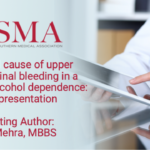Abstract | November 6, 2020
An unusual cause of upper gastrointestinal bleeding in a patient with alcohol dependence- A case presentation
Learning Objectives
- GI bleeding can be life-threatening, and management can occasionally be challenging and needs a multidisciplinary approach to manage the patient.
- Etiology of the visceral artery aneurysms is not well documented in the literature. Still, our patient serves to highlight the association between untreated hypertension, chronic alcohol consumption and smoking, with the pseudoaneurysm formation- likely secondary to the chronic inflammation due to these underlying risk factors.
- In view of the above, when possible, patients should be educated on the effects of elevated blood pressure on the body and the consequences of medication non-adherence in the setting of hypertension. Emphasis must also be placed on the pro-inflammatory effects of chronic alcohol abuse and nicotine dependence, and the importance of cessation of using these substances.
Background: Gastroduodenal artery aneurysms (GDA) are a rare subset of visceral artery aneurysms (VAA), pseudoaneurysm of GDA being an even rarer diagnostic finding. The etiopathogenesis for these aneurysms is unclear; however, chronic inflammatory processes are considered to have significant contribution in the formation of pseudoaneurysms, likely due to injury to the vascular wall. GDAs usually present as gastrointestinal hemorrhage secondary to a ruptured vessel; less common presentations include abdominal discomfort and occasionally these are an incidental finding.1 The mortality associated with a ruptured VAA is very high; hence the importance of timely intervention cannot be overstated.
Case Presentation: We present a 49-year-old African-American Gentleman with history of untreated hypertension, chronic non-steroidal anti-inflammatory medication use, alcohol dependence and nicotine dependence, who presented with acute gastrointestinal (GI) bleeding characterized by melena, associated with diaphoresis and presyncope.
He was euvolemic and hemodynamically stable at presentation with a blood pressure of 121/65, heart rate of 87, and an unremarkable physical exam. Initial evaluation showed hemoglobin (Hb) level of 12, which is his baseline. On emergent Computed Tomography (CT) Angiogram showed features suspicious for intraabdominal pseudoaneurysm at the level of the head of the pancreas. While in hospital, he had ongoing GI bleed resulting in hemodynamic instability, resulting in hypotension (98/56). He was admitted to the intensive care unit (ICU), and his Hb was noted to have dropped from 12 to 9 over approximately 6 hours.
Working Diagnosis: Actively bleeding ulcer, ruptured pseudoaneurysm
Management: Emergent esophagogastroduodenoscopy (EGD) revealed blood in the stomach and a cratered bleeding ulcer with a visible vessel in the duodenal bulb, along with a mass posteriorly. The procedure was challenging and in view of unsuccessful attempts at achieving hemostasis, vascular surgery was consulted. An emergency coil embolization procedure was performed and hemostasis was achieved successfully. (Figure 1 7 2) The patient tolerated the procedure well and did not have a subsequent hemorrhage.

